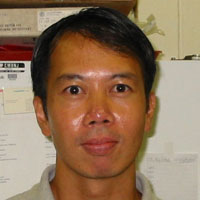The Research Laboratory of Nicholas Ponzio |
||
Overview
|
Lab News
|
Teaching
|

Leo Luistro, M.S.
Pre-doctoral Fellow
Education | Research | Employment | Publications | Presentations | Professional Affiliations
Education:
Leo received his B.S. in Biology from Saint Joseph's University, his M.S. in Molecular Biology from Montclair State University, and completed the requirements for his Ph.D. in Molecular Pathology and Immunology at UMDNJ-GSBS in 2005.
Research:
Thesis Title: Determining the Underlying Mechanisms of Acquired Resistance to Herceptin® (Trastuzumab) in a Preclinical Model of Ovarian Carcinoma
Advisers: Dr. Nicholas M. Ponzio, Vice-chair and Professor, Department of Pathology and Laboratory Medicine, UMDNJ-New Jersey Medical School, Newark, NJ.
Dr. Steve Ritland, Research Leader, Oncology, Hoffmann-La Roche Inc., Nutley, NJ
Abstract: My current thesis project involves investigating the mechanisms of acquired or intrinsic therapeutic resistance to the anti-erbB2 (HER2/neu) antibody, Herceptin, using the SKOV-3 pre-clinical model of ovarian carcinoma. The c-erbB2 or HER2 proto-oncogene is a transmembrane tyrosine kinase cell surface receptor which is overexpressed in 20-30% of breast and ovarian carcinomas. Overexpression of HER2 is associated with more aggressive disease and predicts poor prognosis for survival of HER2-positive cancer patients. Herceptin has been developed as a humanized monoclonal antibody molecularly targeted to bind the HER2 receptor causing downregulation of the constitutive growth-signaling properties of the HER2 network, inhibition of cell-cycle progression and angiogenesis, and activation of immune effector cells leading to antibody-dependent cellular cytotoxicity (ADCC). My research involves developing an SKOV-3 cell line resistant to Herceptin, and determining the cause of the loss of anti-tumor activity to the antibody. My experiments will probe into alterations in the HER2 receptor, alterations in downstream signaling, genetic instability and clonal evolution. The results obtained from this research project will increase our knowledge of resistance mechanisms, enhance our understanding of the HER2 signal transduction events, and potentially impact current developments and clinical usage of anti-erbB cancer therapeutics.
Employment:
Associate Principal Scientist in the Oncology Department at Hoffmann-La Roche Inc., Nutley, NJ
My responsibilities include the testing of potential oncology drugs to become clinical candidates by looking at anti-tumor efficacy and safety in vivo utilizing tumor models in mice and rats. These in vivo efficacy studies involve the implantation of syngeneic and xenografted human cancer cell lines (breast, prostate, lung, colorectal, skin) by orthotopic, subcutaneous and intravenous routes. Specific endpoints to assess efficacy and toxicity are calipered measurements of tumor volumes, pharmacokinetic exposure of drug levels, histopathological analyses of tumors and target organs, and monitored individual animal weights.
Currently, one of my projects is to establish an in vivo model in SCID-beige mice for two human B cell non-Hodgkin's lymphoma (NHL) lines, OCI-Ly3 and OCI-Ly10, which have high constitutive expression of NF-κB. This animal model will be used to test potential therapeutic targeted treatments for NHL. Other potential in vivo model development may involve lymphocytic and monocytic leukemias and myelogenous myeloma.
Publications:
Brunda, M.J., Luistro, L., Rumennik, L., Wright, R., Wigginton, J., Wiltrout, R., Hendrzak, J., Palleroni, A. 1996. Interleukin-12: Murine Models of a Potent Antitumor Agent. Annals of the New York Academy of Sciences. Volume 795: 266-274.
Brunda, M.J., Luistro, L., Rumennik, L., Wright, R., Dvorozniak, M., Aglione, A., Wigginton, J., Wiltrout, R., Hendrzak, J., Palleroni, A. 1996. Antitumor activity of interleukin 12 in preclinical models. Cancer Chemother Pharmacol. 38 (Suppl): S16-S21.
Brunda, M.J., Luistro, L., Hendrzak, J., Fountoulakis, M., Garotta, G., Gately, M. 1995. Role of interferon-γ in mediating the antitumor efficacy of interleukin-12. J. Immunother. 17:71-77.
Brunda, M.J., Wright, R.B., Luistro, L., Harbison, M., Anderson, T., McIntyre, K. 1994. Enhanced antitumor efficacy in mice by combination treatment with interleukin-1-α and interferon-α. J Immunother. 15:233-241.
Brunda, M.J., Luistro, L., Warrier, R.R., Wright, R.B., Hubbard, B., Murphy, M., Wolf, S., Gately, M. 1993. Antitumor and antimetastatic activity of interleukin-12 against murine tumors. J Exp. Med. 178:1223-1230.
Presentations:
91st Annual Meeting of the American Association for Cancer Research (AACR)
April 1- 5, 2000, San Francisco, CA
Posters #199, 217, 218, 219, 220, 221 and 2072.
92nd Annual Meeting of the American Association for Cancer Research (AACR)
March 24-28, 2001, New Orleans, LA
Posters #440, 1598 and 4893.
93rd Annual Meeting of the American Association for Cancer Research (AACR)
April 6-10, 2002, San Francisco, CA
Posters #1040, 3655, and 3656
Professional Affiliations:
Active member of the American Association for Cancer Research (AACR)